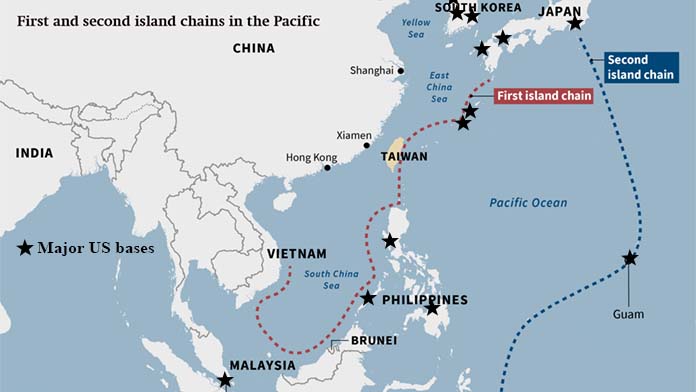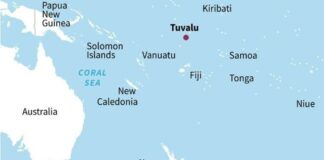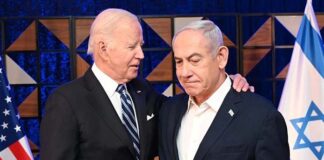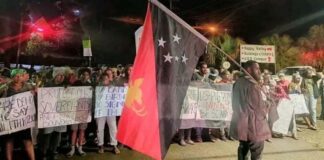The US is the biggest bully in the Pacific, with rings of military bases blocking and threatening China, writes Tom Orsag
The US and Australian governments constantly present China as a military threat, pointing to its claims over Taiwan and its actions in the South China Sea.
But the US has a far more intimidating military arsenal and has not been afraid to use it—from its invasion of Afghanistan and Iraq, pouring of weapons into Ukraine and constant bombing of countries from Syria to Yemen, Somalia and Libya.
China is effectively encircled by US bases all across the Pacific—threatening a catastrophic war between the world’s two greatest powers.
The US became the preeminent power in the Pacific after the defeat of Japan in 1945. It was US military power that won the war, eclipsing the old imperial powers of Britain, France and the Netherlands, who began retreating from their Asian colonies.
Since then the US has sought to maintain control over the entire Pacific Ocean through a string of bases. And it is now expanding its military footprint in the area further as part of preparations for war against China.
Island chain
In 1951 US military planners developed the “first island chain” security theory in an effort to preserve US control of the Pacific—right up to the Chinese coastline.
This was a response to the development of the Cold War in Asia. In October 1949 the US-backed Guomindang lost the civil war in China to the Chinese Communist Party and fled to Taiwan. Then the US fought a bloody war in Korea against North Korean and Chinese troops backed by Russia.
Just as the US Joint Army and Navy Board developed “War Plan Orange” for a possible war with Japan in the 1920s and 1930s, the US developed plans for war against China.
It sought to secure a “first chain” or fence stretching from the Japanese islands to Taiwan, the Philippines, and the island of Borneo (split mainly between Malaysia and Indonesia).
The threat of US firepower stopped Chinese efforts to reclaim Taiwan in 1954 and 1958.
The US also established new military bases across South Korea and occupied Japan and re-established control of bases in the Philippines, which had been a US colony before the war.
Active duty
Most of these bases remain active today. In 2021, the US defence magazine 19FortyFive wrote that, “The U.S. Indo-Pacific Command has some 375,000 military and civilian personnel working across the Asian Pacific.”
The US maintains 56,000 active duty military personnel at more than 80 bases and other facilities across Japan, the most in any one country outside the US. About half are based in Okinawa.
Through the Cold War, the US pointed nuclear weapons at China from bases in Japan, Taiwan and South Korea.
Nuclear weapons were moved from Okinawa to the Iwakuni base near Hiroshima in 1966. When the US ambassador to Japan, Edwin O. Reischauer, learned of their presence, which was a violation of the treaty with Japan, he told the US State Department that he would resign and go public with the information if they were not removed within 90 days. The weapons were removed shortly thereafter.
Improvements in ballistic missile technology and nuclear-armed submarines mean the US no longer needs these nuclear weapons bases. Today there are still 5000 marines and two air force squadrons stationed at Iwakuni.
The US ran Okinawa via an appointed US High Commissioner until May 1972, with local people having no say, after which it was “returned” to Japan. But US troops stayed.
Power projection
Another 30,000 US personnel are based in South Korea, which the US has never left following the Korean War in the 1950s.
Camp Humphreys, southwest of Seoul in South Korea, is the largest US overseas military base in the world with more than 500 buildings. It is just 540 kilometres from the city of Dalian on the Chinese mainland, with a population of more than seven million people. That is the same distance as driving between Sydney and Wodonga on the Victorian border.
The US Army calls the base “the largest power projection platform in the Pacific”.
With the addition of the nearby Osan air base and the Kusan air base another 116 kilometres south, the US can project power both north into North Korea and west into China.
In the Philippines the US still has access to five airbases, following the closure of its large naval base at Subic Bay and the Clark air base in the early 1990s. The Financial Times reported in January that the country is planning to “allow US forces to pre-position weapons and other supplies on five more bases in addition”.
Taiwan is another key link in the chain. The US seeks to guarantee Taiwan’s de facto independence from China through arms sales and military support. A procession of US politicians including Nancy Pelosi have staged provocative visits in the last year to declare their “solidarity” with Taiwan and US President Joe Biden has repeatedly said the US would defend it against any Chinese invasion.
The US also has an agreement with Singapore that allows it to use naval and air bases there, which sit in a vital strategic chokepoint on the straits of Malacca at the entry to the South China Sea.
Blockade
Euan Graham, a fellow in defence and security at the Lowy Institute, has described the island chain as “the US defensive perimeter in the Western Pacific”, adding that “no powers have ever really contested it, not even the Soviet Union during the height of the Cold War”.
Control of it gives the US the capacity to impose a military blockade against China, which is dependent on trade and imports carried by sea, including for 60 per cent of its oil. A blockade of the sea lanes that pass along the islands could be crippling.
The US bases here were never just “defensive”. They have been used to wage a series of US wars in Asia. Clark air base in the Philippines was a major launching pad for the Korean War (1950-1953) and an important logistics hub during the Vietnam War (1954-75).
US Admiral Grant Sharp, commander of Pacific Forces, said in December 1965, “Without Okinawa we couldn’t continue fighting the Vietnam War.” US B-52 bombers flew missions into Vietnam from bases there, which were also a transit point for US combat troops bound for Vietnam.
To assert its control over the Pacific, two more “island chains” have been identified and built up by the US since the theory was first devised.
The “second island chain” stretches from the Bonin (or Ogasawara) islands 1000 kilometres south of Tokyo to the Mariana Islands including Guam, the Caroline islands (part of Micronesia) and West Papua, controlled by Indonesia. South of these are the US bases in Australia around Darwin.
New frontline
Guam is already one of the most important US bases in the Pacific. The US is expanding its operations there to boost its aircraft strike capacities in any war with China.
US bases on Guam, the largest island in the Marianas, include the Andersen Air Force base hosting 8000 US military personnel and their families.
A further 5000 marines are relocating from Okinawa alongside a build-up that “also involves more submarines, ship repair facilities and a planned $1.3 billion missile defence system”, the ABC reported last year. That’s because Guam today is vulnerable to China’s long-range missiles.
The ABC report was headlined “Guam, America’s forgotten speck of an island in the Pacific, is the new frontline against China”.
It noted, without a hint of irony that, “The island…is the western-most piece of American territory in the Pacific, allowing a military build-up that would be more difficult for bases on foreign soil.”
That’s because colonial conquest decimated the Indigenous people—the Chamorro—and the US military force them to sign away their land after it was occupied in 1898, with the military still controlling almost 30 per cent of the island.
The island’s size and strategic location gives it great value to US war plans. “The amount of firepower that we could generate from that island is tremendous,” General Kenneth Wilsbach, the US Pacific Air Forces Commander has noted. “The airfield itself is enormous, with two runways … lots of parking areas, a very large munitions storage area.”
The US also has agreements with Palau, the Federated States of Micronesia and the Marshall Islands, giving it exclusive rights to base military assets there. The US plans to build a new military base in Micronesia and install a high-tech radar surveillance system on Palau.
Alaska to New Zealand
The “third island chain” is an arc from the Aleutian Islands off Alaska to Hawaii through to Fiji and New Zealand.
It includes Wallis and Futuna, part of the French empire and northwest of Fiji. This is why Biden patched up relations with France during President Emmanuel Macron’s state visit to Washington in early December 2022.
A recent article in The Diplomat titled “Why France-US Relations Matter for the Pacific” argues improved US-French relations “should assist geopolitical stability and a democratic rules-based order in the region”, or in other words ongoing US control.
US bases in Australia and the growing integration of Australia’s armed forces into the US military are another part of its push against China.
We should oppose all the US bases in Australia, including Pine Gap (NT), the North West Cape (WA), and the new B-52 build-up at Tindal (NT).
The US is not some force for democracy. It is a ruthless imperialist power that seeks to dominate the entire planet. We should oppose US bases and its preparations for war with China everywhere.






